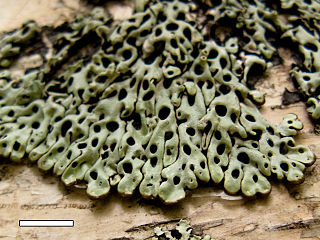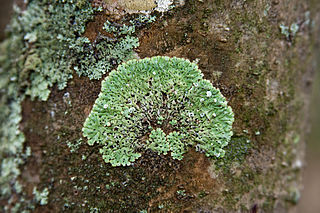
Parmelia is a genus of medium to large foliose lichens. It has a global distribution, extending from the Arctic to the Antarctic continent but concentrated in temperate regions. There are about 40 species in Parmelia. In recent decades, the once large genus Parmelia has been divided into a number of smaller genera according to thallus morphology and phylogenetic relatedness.

The Parmeliaceae is a large and diverse family of Lecanoromycetes. With over 2700 species in 71 genera, it is the largest family of lichen-forming fungi. The most speciose genera in the family are the well-known groups: Xanthoparmelia, Usnea, Parmotrema, and Hypotrachyna.

Punctelia is a genus of foliose lichens belonging to the large family Parmeliaceae. The genus, which contains about 50 species, was segregated from genus Parmelia in 1982. Characteristics that define Punctelia include the presence of hook-like to thread-like conidia, simple rhizines, and point-like pseudocyphellae. It is this last feature that is alluded to in the vernacular names speckled shield lichens or speckleback lichens.

Menegazzia is a genus of lichenized fungi containing roughly 70 accepted species. The group is sometimes referred to as the tree flutes, honeycombed lichens, or hole-punch lichens. The most obvious morphological feature of the genus is the distinctive perforations spread across the upper side of the thallus. This makes the group easy to recognise, even for those not particularly familiar with lichen identification.
Menegazzia aeneofusca is a species of lichen from South America, New Zealand, and Australia.
Menegazzia inactiva is a species of foliose lichen found in New Zealand and Australia. The type locality of this species is in Tasmania, south of Arthur River near Sumac Road. The species was discovered on Tasmannia lanceolata in rainforest habitat. The type specimen is held at the herbarium of the Tasmanian Museum and Art Gallery.
Menegazzia magellanica is a species of foliose lichen from South America. It was described as a new species in 1942 by Swedish lichenologist Rolf Santesson.
Menegazzia platytrema is a species of lichen found in Australia.

Menegazzia subsimilis is a species of lichen in the family Parmeliaceae It is found scattered across the world, including Oceania, Asia, Europe, South America, the Caribbean and North America. It has recently been recorded for the first times in Tibet (2005), in the British Isles, and in Malaysia and Indonesia (2007).
Menegazzia valdiviensis is a species of lichen found in South America. It was first described in 1932 as Parmelia valdiviensis by Finnish lichenologist Veli Räsänen. Rolf Santesson transferred it to the genus Menegazzia in 1942.
Menegazzia wandae is a species of foliose lichen found in South America. It was described as new to science in 2001, and was named after the Chilean lichenologist, Wanda Quilhot.
Menegazzia weindorferi is a species of foliose lichen found in Australia. It was originally described by Austrian botanist Alexander Zahlbruckner as a species of Parmelia in 1907. Rolf Santesson transferred it to Menegazzia in 1942.
Menegazzia wilsonii is a species of lichen found in South America. It was first described to science as Anzia wilsonii by Veli Johannes Paavo Bartholomeus Räsänen in 1944, transferred to the genus Pannoparmelia in 1978, and finally transferred to Menegazzia in 2005.
Rolf Santesson (1916–2013) was a Swedish lichenologist and university lecturer. He was awarded the Acharius Medal in 1992 for his lifetime contributions to lichenology.
James Stirton was a Scottish physician and one of Scotland's leading experts on cryptogamic botany. His investigations in bryology and lichenology earned him a world-wide reputation.
Peter Wilfred James (1930–2014) was an English botanist and lichenologist. He was a pioneer in the study of lichens as "environmental indicators, especially in atmospheric pollution".

Punctelia reddenda is a widely distributed species of foliose lichen in the family Parmeliaceae. It occurs in Africa, Europe, North America, and South America, where it grows on bark and on rock.
Punctelia subalbicans is a species of foliose lichen in the family Parmeliaceae. It is found in Australia and New Zealand, where it grows on the bark of various tree species.
Calycidium is a genus of lichen-forming fungi in the family Sphaerophoraceae. It has two species. It is one of the few lichen genera containing foliose (leafy) species that produce a mazaedium – a powdery mass of spores. Both species occur in Australasia and South America, where they grow on tree bark or on mosses.
Menegazzia fortuita is a species of foliose lichen in the family Parmeliaceae. Found in Australia, it was described as a new species in 2017 by lichenologists John Elix and Patrick McCarthy. The type specimen was collected in Morton National Park where it was found in an open rocky ridge growing on sandstone. The specific epithet fortuita refers to its discovery: "an unplanned field-stop that led to the discovery of the most recent collection which, fortuitously, helped to resolve the identity of several older, unnamed specimens". The lichen is known to occur only in a few locations in Morton National Park where it grows on sandstone in open Eucalyptus woodland. The expected results for standard chemical spot tests are cortex K+ (yellow); medulla K+ (yellow), C–, KC–; P+ (yellow-orange). Menegazzia fortuita contains several secondary chemicals: stictic acid as a major component, atranorin and constictic acid as minor components, and trace amounts of peristictic acid, cryptostictic acid, and menegazziaic acid.






